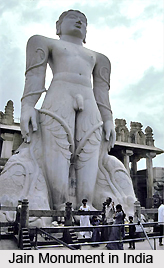 Revivalist Movement in Jainism began from the early years of the twentieth century in different parts of India. The movements were lunched by the intellectuals and social workers amongst Jains. These movements were essentially directed towards brining about necessary reforms in the fields of marriage, education social customs and tradition. The main aim of these social reform movements of the Jains was to bring about major changes in several practices connected with different aspects of marriage, such as age of marriage, preliminaries to marriage, selection of marriage partners, celebration of marriage ceremony, and widow remarriage. It also made a considerable contribution in the field of education also.
Revivalist Movement in Jainism began from the early years of the twentieth century in different parts of India. The movements were lunched by the intellectuals and social workers amongst Jains. These movements were essentially directed towards brining about necessary reforms in the fields of marriage, education social customs and tradition. The main aim of these social reform movements of the Jains was to bring about major changes in several practices connected with different aspects of marriage, such as age of marriage, preliminaries to marriage, selection of marriage partners, celebration of marriage ceremony, and widow remarriage. It also made a considerable contribution in the field of education also.
Education System
In the early stages, there was a controversy between the traditional and modern form of education. There was a debate whether to carry on the orthodox system of religious education through `Pathsalas` i.e. indigenous schools or to accept the new system of secular education transmitted through schools and colleges that were started by the government or by the other public bodies.
Later it was decided to popularize secular learning but, at the same time, importance was also given to religious education to the maximum extent possible. As a result, along with religious education, secular education was also brought within the reach of all members of the Jain community. Residential schools and colleges known as Gurukulas were started. Here the students where prepared for different university courses but care was taken that they strictly adhere to the religious life.
With time the Gurukul system of education became popular as the students trained by these institutions received modern education as well as they remained religious- minded throughout their life. The Gurukula at Karanja in Maharashtra and the Yashovijayaji Jain Gurukul at Palitana in Gujarat are notable institutions of this type. There are only few Gurukulas as heavy expenditure is required for their establishment and maintenance. Boarding houses or hostels were established where Gurukulas could not be built. These hostels were set up practically at all big places and centres of education throughout India. Residential housing is provided to Jain students at these places free of cost or on nominal rates. All the students staying in these hostels were free to join any institution for their education. However, they had to take elementary religious education at the beginning. For this, various provision have been made by the authorities to help these students lead a religious life i.e. to visit the temple daily, to refrain from eating at night or eating prohibited things, etc.
To provide equal education opportunity to all poor and deserving hostel students were given financial help. To accelerate the spread of education scholarships or loans are given to deserving Jain students wherever they may be. The scholarships are provided on the condition that the receiver would refund the amount by instalments once he completes his education and becomes settled in his life.
 While scholarships are provided to the students preference is given to those who wish to pursue higher studies in Jainology or have interest in doing specialized courses. Presently the spread of higher education amongst Jains has been possible for the help rendered to them by the Jain community. The Jain institutions also took proper measures to spread female education. Like boarding houses or students` hostels for boys, women`s homes, Shravikashrams were also established by Jains at prominent places.
While scholarships are provided to the students preference is given to those who wish to pursue higher studies in Jainology or have interest in doing specialized courses. Presently the spread of higher education amongst Jains has been possible for the help rendered to them by the Jain community. The Jain institutions also took proper measures to spread female education. Like boarding houses or students` hostels for boys, women`s homes, Shravikashrams were also established by Jains at prominent places.
Women Education
The Shravikashrams were specially established, designed and organized for imparting religious and secular education to female students, to provide lodgings for working women, to give residential facilities to female students enrolled in other institutions, to provide shelter to orphans, widows and deserted women and, in recent times, to arrange vocational training and run small scale industries for the benefit of women. Special scholarship funds were also given to the poor and deserving women students so as to encourage talented girls to take specialized training courses required for different careers and professions. It can also be stated that many undesirable and anti-social customs and traditions that were prevalent in other societies, were not practised in the Jain society. For example, in ancient times, in almost all patriarchal societies, the birth of a girl was not a welcome event and this gave rise to practices like female infanticide and neglect of female children.
Upliftment of Women
During the medieval period the practise of infanticide of girls crept in the Hindu society. Later it was prohibited by the early British rulers. However it was never practised in then Jain community at any time as the Jain doctrine is established on the main principle of Non-violence or non-injury to life forms. It was this reason that the female children were never purposefully neglected in the Jain community. The practice of `sati` i.e. self-immolation by widows was very common amongst the Hindus but again it was never practised among the Jains.
The custom of tonsure was practiced by Hindu widows from about 1200 AD. It was in trend until recently it was prohibited. However, it was never practised by the Jain widows. Amongst the Jain women only the Sadhvis (nuns) used to be shaved in accordance with the rules of asceticism prescribed for them. For the establishment of social customs and traditions several Jain associations were started. Apart from these many Jain journals and newspapers were also started during the British period at the national, regional and social levels. These mediums tried all ways of propaganda and education to eradicate irreligious practices which had crept into the Jain community from medieval times. It was the result of lack of knowledge of Jain doctrine and Holy Scriptures as well as the impact of devotees of other religions and customs on Jains. Thus because of their untiring efforts that all evil social practises like bride-price, child marriage, extra expenditure on ceremonies connected with pregnancy and death, beating breasts while sorrowing over the death of an individual, etc. became infrequent.
Religious Development
The Revivalist Movement has generated great interest in Jain religion, history, literature, and culture. However, the efforts made have not yet succeeded in bringing about a sense of oneness amongst all Jains, irrespective of differences of denomination, caste, religion, language or occupation. With time different denominations and sub-sects began developing within Jainism and hence changes in values and new developments emerged within a particular religious faith.
New denominations like the Sthankavasi, the Terapanth and the Kanjipanth also developed with Jainism. Certain key religious leaders have also been instrumental in bringing the reformatory spirit in Jainism.



















